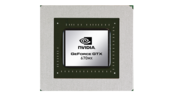NVIDIA GeForce GTX 675M SLI vs NVIDIA GeForce GTX 670MX
NVIDIA GeForce GTX 675M SLI
► remove from comparison
Die NVIDIA GeForce GTX 675M SLI ist eine High-End Grafiklösung für Laptops welche auf zwei "Fermi" Chips (GF114) basiert. Die beiden Grafikkarten werden durch eine SLI Bridge verbunden und rendern normalerweise abwechselnd ein Bild (AFR). Dadurch kann es auch zu Mikrorucklern kommen (ungleichmäßige Abstände zwischen zwei Bildern führen zu spürbaren Rucklern trotz flüssiger fps Raten von etwa 30 fps). Die GTX 675M SLI unterstützt DirectX 11 und braucht sehr viel Strom (2x 100 Watt für das gesamte Board inkl 2GB GDDR5) und kommt daher nur in großen und schweren DTR Notebooks zum Einsatz. Die GTX 675M ist auch als SLI-Lösung exakt identisch mit der GTX 580M.
Im Gegensatz zur GeForce GTX 485M basiert jede einzelne GTX 675M auf dem auf Stromverbrauch optimierten GF114 Chip und nicht mehr dem GF104. Die Architektur und Performance pro MHz ist dadurch nicht betroffen, jedoch sind nun höhere Taktfrequenzen bei vergleichbarem Stromverbrauch möglich. Der GF114 basiert auf der Fermi Architektur und bietet im Vollausbau 384 Kerne, 64 Textur-Einheiten (TMUs) und 32 Raster-Operations-Einheiten (ROPs). Mehr Informationen zur Architektur des ähnlichen GF104 finden Sie auf der Seite der GeForce GTX 485M.
Die Grafikleistung der 675M SLI liegt dank der höheren Taktraten etwas oberhalb der 485M SLI und auf einem Niveau mit der GTX 580M SLI. Dadurch kann man anspruchsvolle Spiele wie Crysis 2, Dirt 3 oder Metro 2033 in 1920x1080 und hohen Details flüssig spielen. Die meisten Spiele sind auch mit Antialiasing und maximalen Details flüssig darstellbar.
Wie auch die GeForce 300M Serie, bietet die Geforce GTX 675M PureVideo HD mit dem VideoProcessor 4 (VP4) und VDPAU Feaure Set C. Dadurch kann die Grafikkarte HD Videos in H.254, VC-1, MPEG-2 und MPEG-4 ASP vollständig dekodieren ohne den Prozessor zu belasten. Mittels Flash 10.1 können auch Flash Videos GPU unterstützt wiedergegeben werden.
Eine Neuheit des GF114 Chips im Vergleich zum GF100 (GTX 480M) ist die Unterstützung der Bitstream Übertragung von HD Audio (Blu-Ray) per HDMI Anschluss. Wie die Radeon HD 5850, kann die GTX 675M Dolby True HD und DTS-HD per Bitstream ohne Qualitätsverlust an einen geeigneten Receiver übertragen.
Die Rendering Cores der Nvidia GeForce GTX 675M können dank CUDA und DirectCompute Unterstützung auch für generelle Berechnungen (z.B. das Encodieren von Videos) verwendet werden. Weiters kann man mittels PhysX die Rechenkerne für Physikberechnungen einsetzen. So kann man z.B. eine Grafikkarte dediziert für PhysX abstellen und die zweite Karte des SLI Verbunds berechnet die Grafikausgabe.
Im Vergleich zu Desktop Grafikkarten, ist die GeForce GTX 675M SLI vergleichbar mit zwei GeForce GTX 560Ti im SLI Modus. Die 560Ti ist jedoch deutlich höher getaktet und dadurch schneller.
NVIDIA GeForce GTX 670MX
► remove from comparison
Die NVIDIA GeForce GTX 670MX ist eine High-End Grafikkarte für Notebooks. Trotz des ähnlichen Namens zur Fermi-basierten GTX 670M basiert die GTX 670MX auf dem neueren Kepler GK106 Kern in 28nm. Im Vergleich zur GTX 675MX bietet die 670MX einen verringerten Speicherbus und langsamer getaktete Speicherchips. Dadurch ist die Speicherbandbreite von 115,2 GB/s auf 67,2 GB/s reduziert.
Architektur
Mit Kepler löst Nvidia die bisherige Fermi-Architektur ab, die unter anderem bei verschiedenen Chips und Modellen der GeForce-500M-Serie zum Einsatz kam. Der GK106 verfügt als Kepler-Chip über 5 Shader-Blöcke mit je 192 CUDA Cores, die vom Hersteller mit dem Kürzel SMX bezeichnet werden. Bei der 670MX sind davon alle 5 aktiviert. Zwei SMX bilden zusammen mit zwei Polymorph Engines und einer gemeinsamen Raster Engine einen sogenannten GPC (Graphics Processing Cluster). Da die Shader keine eigene Takt-Domain mehr besitzen (Hot Clock), entspricht die Rechenleistung in etwa der Hälfte der Einheiten der Fermi-Architektur mit doppelter Taktrate. Diese Änderung ist einer der Gründe dafür, dass sich laut Nvidia die Energieeffizienz gegenüber dem Vorgänger verdoppelt hat. Auch die Tesselations-Leistung soll - speziell bei hohen Faktoren - noch einmal deutlich verbessert worden sein.
Als weitere Neuerungen werden zudem erstmals PCIe 3.0 sowie ein noch nicht näher bezeichneter, optionaler Turbo-Modus unterstützt. Dieser kann - ausreichende Kühlungsreserven vorausgesetzt - die Kerntaktrate um bis zu 15 Prozent anheben. Da der Turbo vom BIOS gesteuert wird, steht er, falls vom Notebook-Hersteller implementiert, unabhängig vom Betriebssystem zur Verfügung.
Leistung
Die Leistung der GeForce GTX 670MX liegt etwas oberhalb der alten GTX 670M und dadurch in der Oberklasse der Notebookgrafikkarten in 2012. Die meisten anspruchsvollen Spiele wie Anno 2070 oder Battlefield 3 sind somit in hohen Auflösungen und Detailstufen flüssig darstellbar, teils auch mit zusätzlichem Antialiasing (Stand 2012).
Features
Das aktualisierte Featureset umfasst nun die Unterstützung von bis zu 4 aktiven Displays (mit Optimus u.U. weniger), die mit einer maximalen Auflösung von 3.840 x 2.160 Pixeln zum Beispiel über DisplayPort 1.2 oder HDMI 1.4a angesteuert werden können. HD-Audio-Formate wie Dolby True HD und DTS-HD lassen sich als Bitstream an einen geeigneten Receiver senden. Wie in der Vergangenheit kann jedoch auch weiterhin 3D Vision nicht mit Optimus-Unterstützung kombiniert werden.
Der HD-Videoprozessor der fünften Generation (VP5) wurde vom GF119-Chip übernommen. Dieser kann die Formate MPEG-1, MPEG-2, MPEG-4, H.264 und VC1/WMV9 bis zu einer Auflösung von 4k decodieren und somit den Prozessor entlasten. Auch zwei parallele Streams, beispielsweise für Picture-in-Picture bei einer Blu-Ray, sind möglich. Eine weitere Neuerung ist die Integration eines dedizierten Videoencoders ähnlich Intels Quick Sync, der über die NVENC-API angesprochen werden kann.
Die Leistungsaufnahme der GTX 670MX sollte auf dem selben Level oder etwas unterhalb der GTX 670M liegen, somit eignet sich die Grafikkarte für große und schwere Notebooks (15-17"+). Bei geringer Last helfen zusätzliche Taktstufen, um Energie zu sparen. Im Leerlauf kann die GPU mithilfe der Optimus-Technologie zugunsten einer integrierten Grafikeinheit auch vollständig deaktiviert werden (nur ohne 3D Vision).
| NVIDIA GeForce GTX 675M SLI | NVIDIA GeForce GTX 670MX | |||||||||||||||||||||||||||||||||||||||||||||||||||||||||||||
| GeForce GTX 600M Serie |
|
| ||||||||||||||||||||||||||||||||||||||||||||||||||||||||||||
| Codename | N12E-GTX2 | N13E-GR | ||||||||||||||||||||||||||||||||||||||||||||||||||||||||||||
| Architektur | Fermi | Kepler | ||||||||||||||||||||||||||||||||||||||||||||||||||||||||||||
| Pipelines | 768 - unified | 960 - unified | ||||||||||||||||||||||||||||||||||||||||||||||||||||||||||||
| Kerntakt | 620 MHz | 600 MHz | ||||||||||||||||||||||||||||||||||||||||||||||||||||||||||||
| Shadertakt | 1240 MHz | |||||||||||||||||||||||||||||||||||||||||||||||||||||||||||||
| Speichertakt | 3000 MHz | 2800 MHz | ||||||||||||||||||||||||||||||||||||||||||||||||||||||||||||
| Speicherbandbreite | 256 Bit | 192 Bit | ||||||||||||||||||||||||||||||||||||||||||||||||||||||||||||
| Speichertyp | GDDR5 | GDDR5 | ||||||||||||||||||||||||||||||||||||||||||||||||||||||||||||
| Shared Memory | nein | nein | ||||||||||||||||||||||||||||||||||||||||||||||||||||||||||||
| API | DirectX 11, Shader 5.0 | DirectX 11, Shader 5.1, OpenGL 4.2 | ||||||||||||||||||||||||||||||||||||||||||||||||||||||||||||
| Stromverbrauch | 2x 100 Watt | 75 Watt | ||||||||||||||||||||||||||||||||||||||||||||||||||||||||||||
| Herstellungsprozess | 40 nm | 28 nm | ||||||||||||||||||||||||||||||||||||||||||||||||||||||||||||
| Features | Optimus, SLI, PhysX, Verde Drivers, CUDA, 3D Vision, 3DTV Play | Optimus, SLI, PhysX, Verde Drivers, CUDA, 3D Vision, 3DTV Play | ||||||||||||||||||||||||||||||||||||||||||||||||||||||||||||
| Notebookgröße | groß (17" z.B.) | groß (17" z.B.) | ||||||||||||||||||||||||||||||||||||||||||||||||||||||||||||
| Erscheinungsdatum | 06.01.2011 = 5161 days old | 01.10.2012 = 4527 days old | ||||||||||||||||||||||||||||||||||||||||||||||||||||||||||||
| Herstellerseite | www.nvidia.com | www.geforce.com | ||||||||||||||||||||||||||||||||||||||||||||||||||||||||||||
| Transistors | 2.5 Billion |
Benchmarks
3DM Vant. Perf. total + NVIDIA GeForce GTX 675M SLI
specvp11 snx-01 + NVIDIA GeForce GTX 670MX
Average Benchmarks NVIDIA GeForce GTX 675M SLI → 100% n=4
Average Benchmarks NVIDIA GeForce GTX 670MX → 67% n=4
* Smaller numbers mean a higher performance
1 This benchmark is not used for the average calculation
Spiele-Benchmarks
Die folgenden Benchmarks basieren auf unseren Spieletests mit Testnotebooks. Die Performance dieser Grafikkarte bei den gelisteten Spielen ist abhängig von der verwendeten CPU, Speicherausstattung, Treiber und auch Betriebssystem. Dadurch müssen die untenstehenden Werte nicht repräsentativ sein. Detaillierte Informationen über das verwendete System sehen Sie nach einem Klick auf den fps-Wert.

Titanfall
2014
Thief
2014
X-Plane 10.25
2013
Call of Duty: Ghosts
2013
Battlefield 4
2013
F1 2013
2013
Fifa 14
2013
Total War: Rome II
2013
Saints Row IV
2013
Dota 2
2013
Company of Heroes 2
2013
GRID 2
2013
Metro: Last Light
2013
BioShock Infinite
2013
SimCity
2013
Tomb Raider
2013
Crysis 3
2013
Dead Space 3
2013
Far Cry 3
2012
Assassin´s Creed III
2012
Hitman: Absolution
2012
Dishonored
2012
World of Tanks v8
2012
Fifa 13
2012
F1 2012
2012
Borderlands 2
2012
Guild Wars 2
2012
Counter-Strike: GO
2012
Darksiders II
2012
Sleeping Dogs
2012
Max Payne 3
2012
Dirt Showdown
2012
Diablo III
2012
Risen 2: Dark Waters
2012
Mass Effect 3
2012
Alan Wake
2012
Anno 2070
2011
Battlefield 3
2011| NVIDIA GeForce GTX 670MX | low | med. | high | ultra | QHD | 4K |
|---|---|---|---|---|---|---|
| Titanfall | 60 | 57.8 | 48.1 | 35.3 | ||
| Thief | 54.6 | 39.7 | 34.4 | 18.5 | ||
| Assassin´s Creed IV: Black Flag | 61 | 50.2 | 31.8 | 16.3 | ||
| X-Plane 10.25 | 82.5 | 38.9 | 22.3 | 13.7 | ||
| Call of Duty: Ghosts | 81.1 | 65.5 | 38 | 19.2 | ||
| Battlefield 4 | 98.4 | 68.8 | 44.9 | 18.6 | ||
| Batman: Arkham Origins | 201 | 132 | 64 | 31 | ||
| F1 2013 | 154 | 120 | 111 | 61 | ||
| Fifa 14 | 450.4 | 316.9 | 315.9 | 238.6 | ||
| Total War: Rome II | 156.8 | 116.4 | 91.3 | 16.6 | ||
| Saints Row IV | 77 | 67.9 | 38.1 | 24.8 | ||
| The Bureau: XCOM Declassified | 119.6 | 84.4 | 33.8 | 17.4 | ||
| Splinter Cell: Blacklist | 93.3 | 82.8 | 38.8 | 17.9 | ||
| Dota 2 | 106.8 | 85 | 44 | |||
| Company of Heroes 2 | 42.7 | 35.8 | 23.2 | 11 | ||
| GRID 2 | 146.5 | 111.3 | 101.7 | 28.7 | ||
| Metro: Last Light | 71.9 | 57.6 | 34.3 | 18.3 | ||
| BioShock Infinite | 158.1 | 91.8 | 78.3 | 27.9 | ||
| StarCraft II: Heart of the Swarm | 238.2 | 102.1 | 84.6 | 34.5 | ||
| SimCity | 77.6 | 40.9 | 34.5 | 21.7 | ||
| Tomb Raider | 201.1 | 104.9 | 66.5 | 28 | ||
| Crysis 3 | 84.9 | 50.7 | 35 | 13.8 | ||
| Dead Space 3 | 291.4 | 143.9 | 109.7 | 66 | ||
| Far Cry 3 | 110.7 | 82.2 | 44 | 13 | ||
| Assassin´s Creed III | 57.3 | 56 | 21 | |||
| Hitman: Absolution | 69.2 | 59.4 | 31 | 13 | ||
| Call of Duty: Black Ops 2 | 128.4 | 113.1 | 71 | 43 | ||
| Need for Speed: Most Wanted | 60 | 60 | 50 | 29 | ||
| Medal of Honor: Warfighter | 117.1 | 78 | 62.6 | 25 | ||
| Dishonored | 129.3 | 127.2 | 116 | 75 | ||
| World of Tanks v8 | 115.4 | 74.2 | 65.8 | 38.2 | ||
| Fifa 13 | 472.1 | 339.9 | 296.3 | 180.6 | ||
| F1 2012 | 154 | 122 | 111 | 45 | ||
| Borderlands 2 | 109.8 | 96.3 | 70 | 45 | ||
| Guild Wars 2 | 86.1 | 44 | 18 | |||
| Counter-Strike: GO | 244.4 | 222.9 | 164.4 | 95.7 | ||
| Darksiders II | 108.9 | 63.2 | ||||
| Sleeping Dogs | 132.1 | 98.6 | 49 | 13 | ||
| Max Payne 3 | 72.4 | 70 | 33 | 25 | ||
| Dirt Showdown | 93.7 | 73.3 | 76 | 32 | ||
| Diablo III | 236.3 | 165.4 | 144 | 89.5 | ||
| Risen 2: Dark Waters | 88.1 | 61.4 | 48 | 23.4 | ||
| Mass Effect 3 | 59.9 | 59.9 | 57.6 | |||
| Alan Wake | 79.3 | 47.3 | 23 | |||
| Anno 2070 | 228.4 | 102.9 | 63 | 32 | ||
| The Elder Scrolls V: Skyrim | 81.8 | 59 | 33 | |||
| CoD: Modern Warfare 3 | 263.8 | 168.1 | 109.8 | 61 | ||
| Battlefield 3 | 95.6 | 71.9 | 52 | 21 | ||
| < 30 fps < 60 fps < 120 fps ≥ 120 fps | 3 24 18 | 11 25 10 | 2 22 17 4 | 27 12 7 2 | | |
Eine Liste mit weiteren Spielen und allen Grafikkarten finden Sie auf unserer Seite: Welches Spiel ist mit welcher Grafikkarte spielbar?






















